Abstract
The effects of Class I antiarrhythmic drugs on the maximum rate of depolarization (Vmax) of guinea-pig ventricular action potentials were studied by standard microelectrode techniques. The ability of seven different drugs to depress Vmax in unstimulated tissue ('resting block') was found to correlate poorly with the lipophilicity (log P) of the compounds and only a little better with their molecular weights. Depression of Vmax in stimulated tissue was studied for 11 drugs and found, in all cases, to increase with stimulation frequency ('rate-dependent block'). The rapidity of onset of rate-dependent block (at approximately equipotent concentrations) varied markedly between drugs. It correlated well with molecular weight (r = 0.83; P less than 0.01). The time constant of recovery from rate-dependent block (tau re) also correlated very well with molecular weight (r = 0.94; P less than 0.001) for the seven drugs thus studied. A simplified model for the interaction of Class I drugs with the fast sodium channel is proposed in which the drugs all act as 'inactivation enhancers' (as suggested by other workers) but in which their molecular weight plays a central role in determining the kinetics of this interaction.
Full text
PDF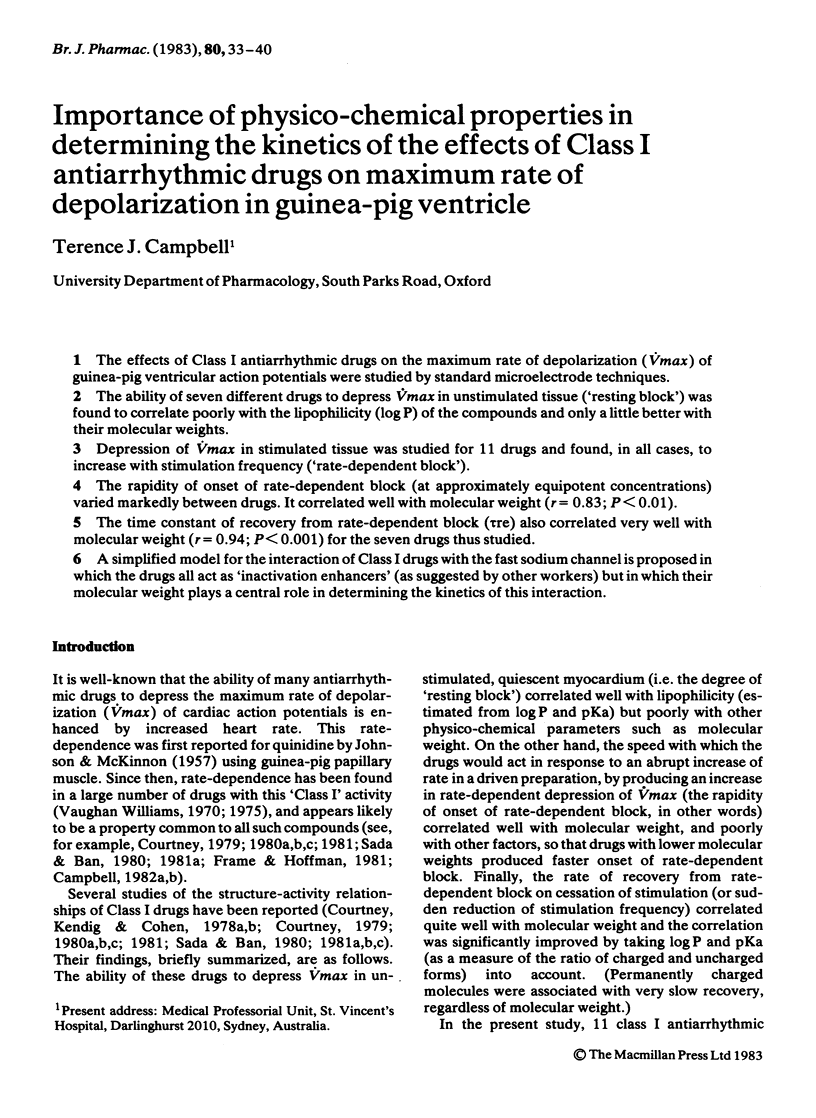
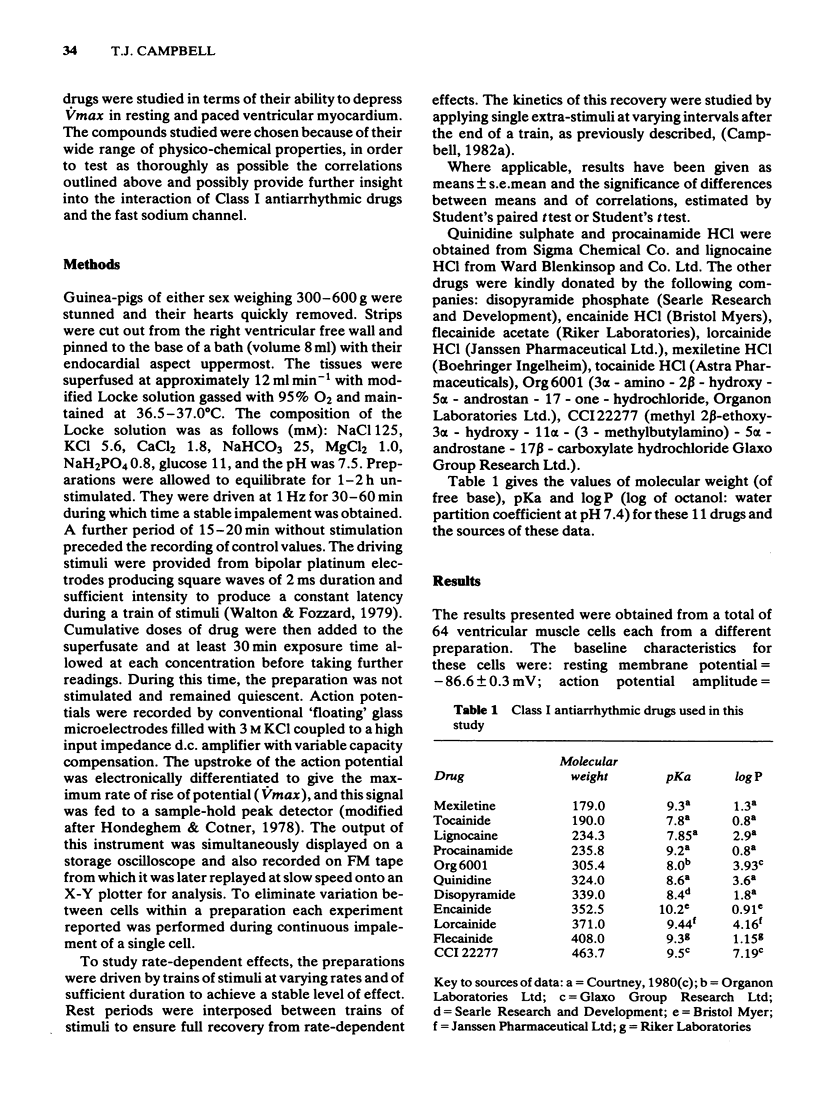
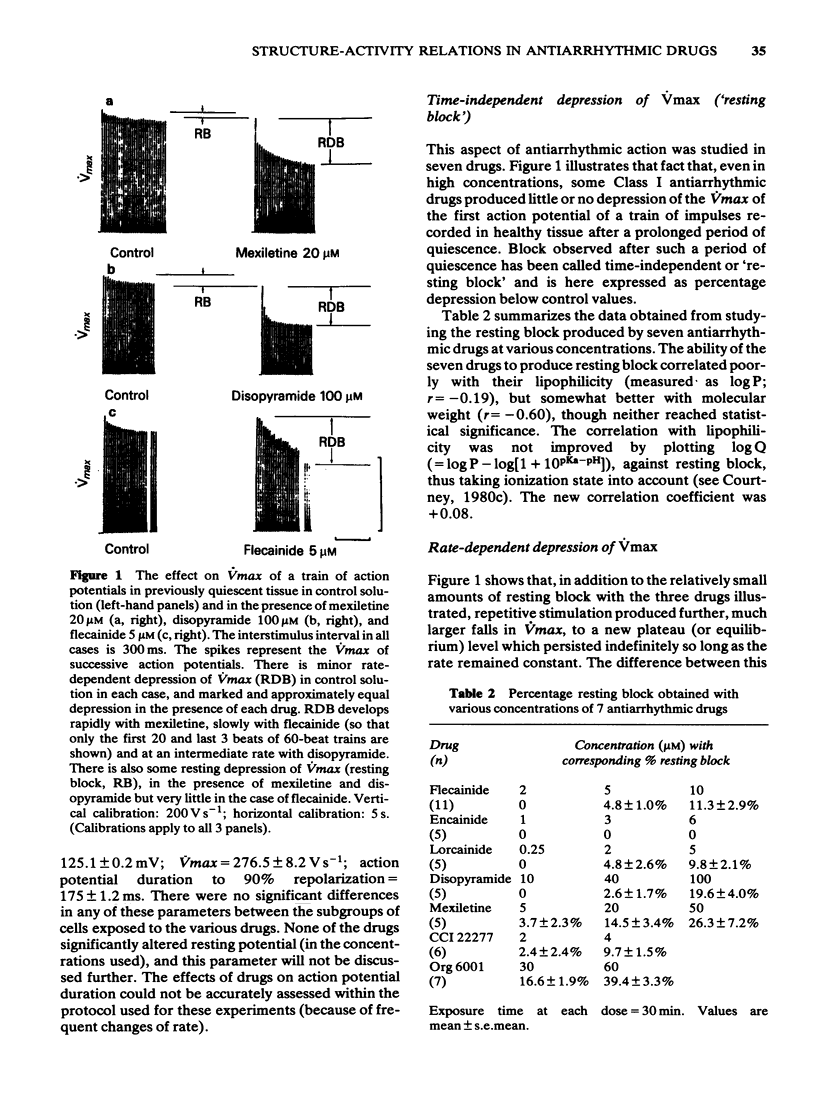
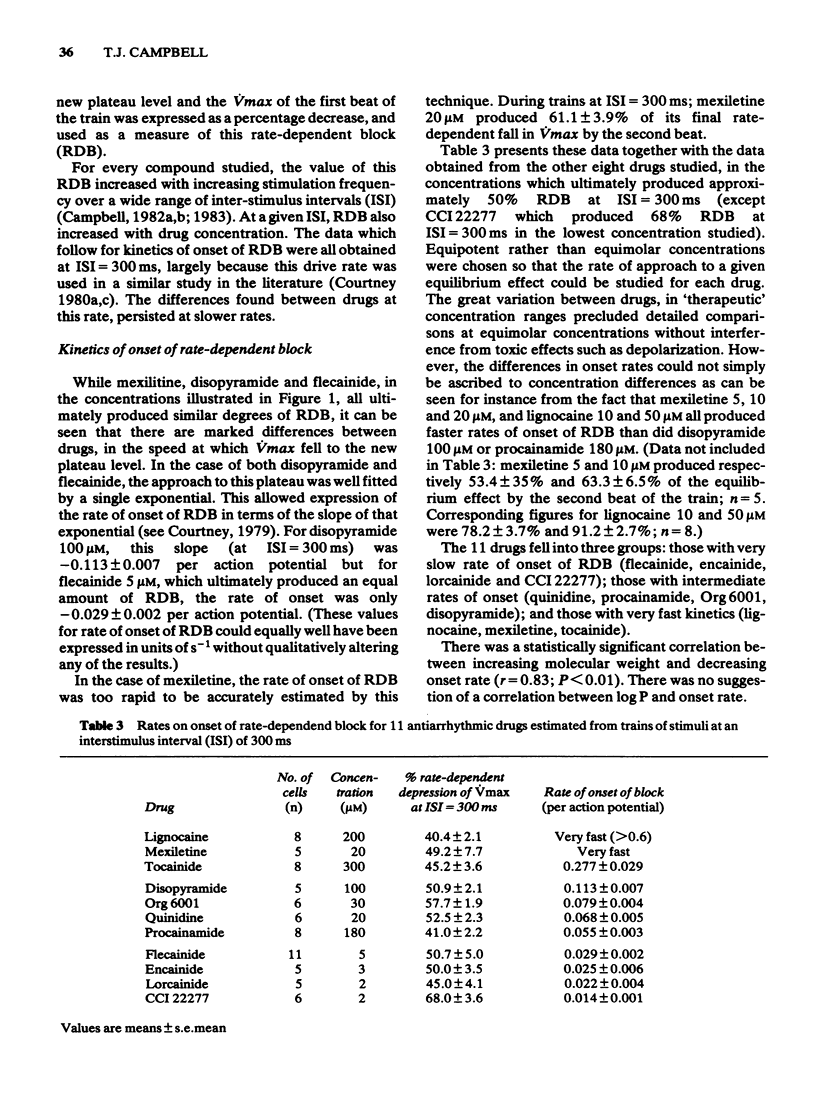
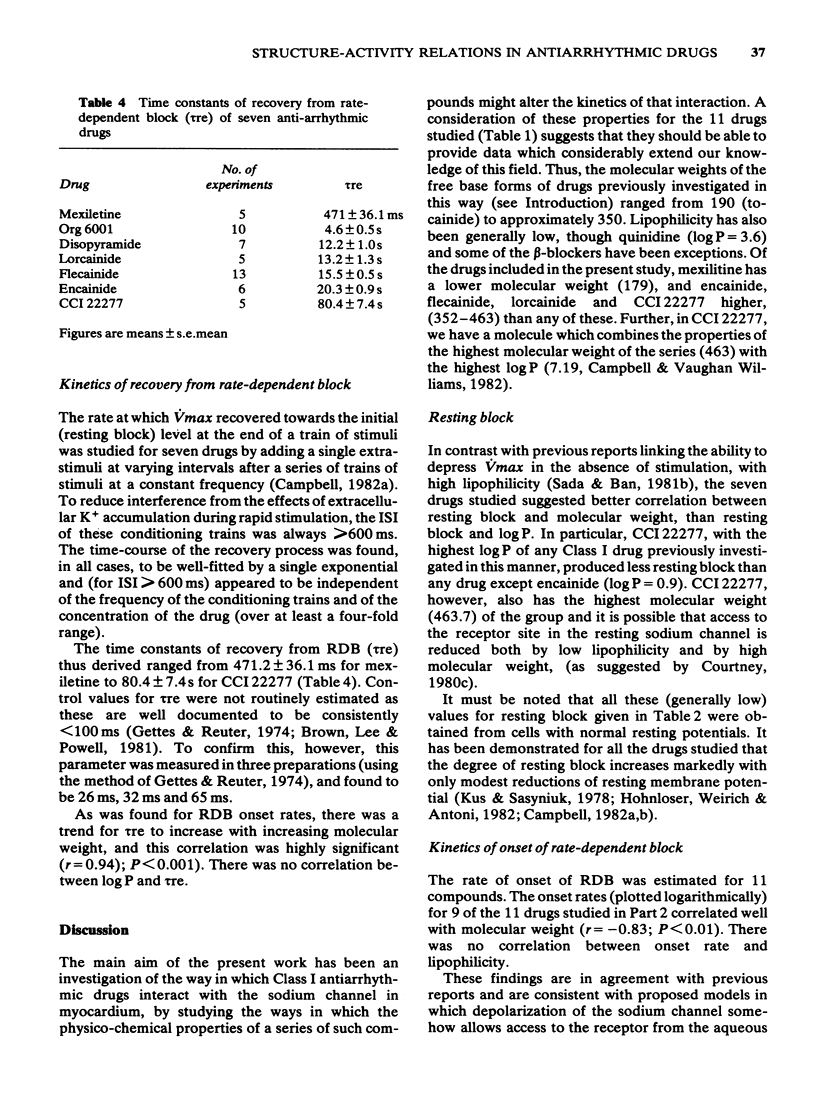
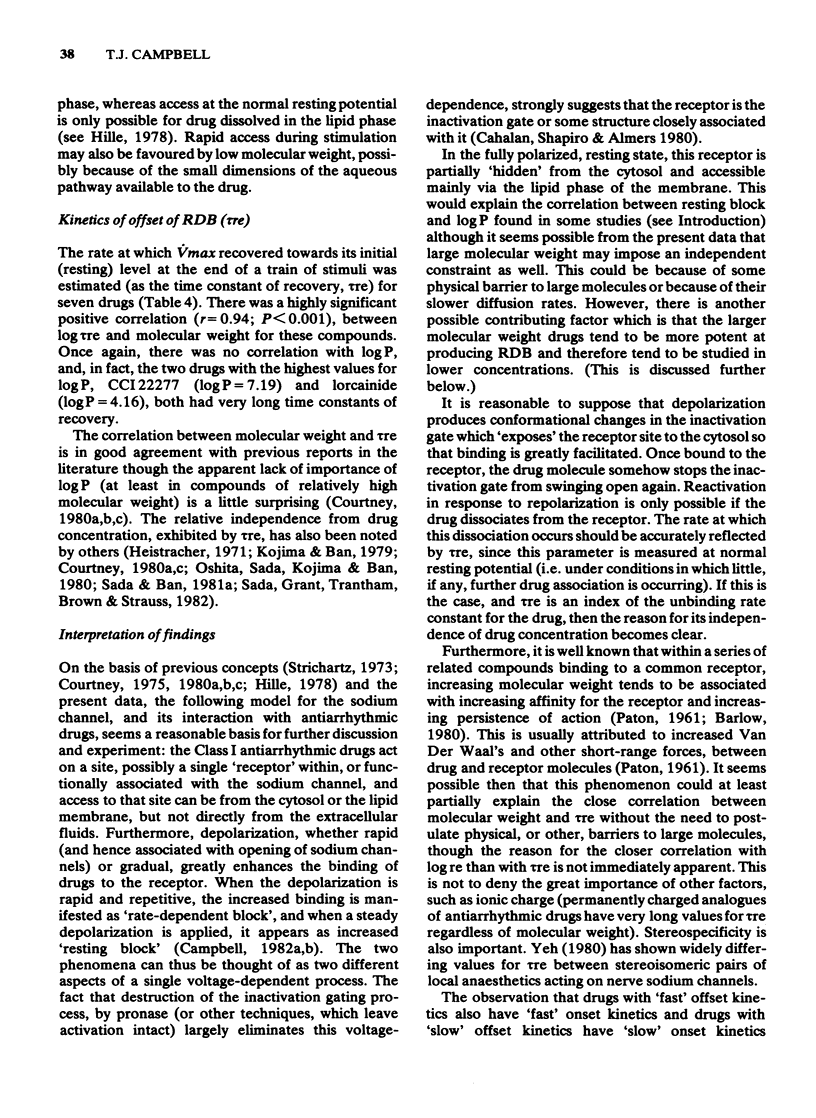
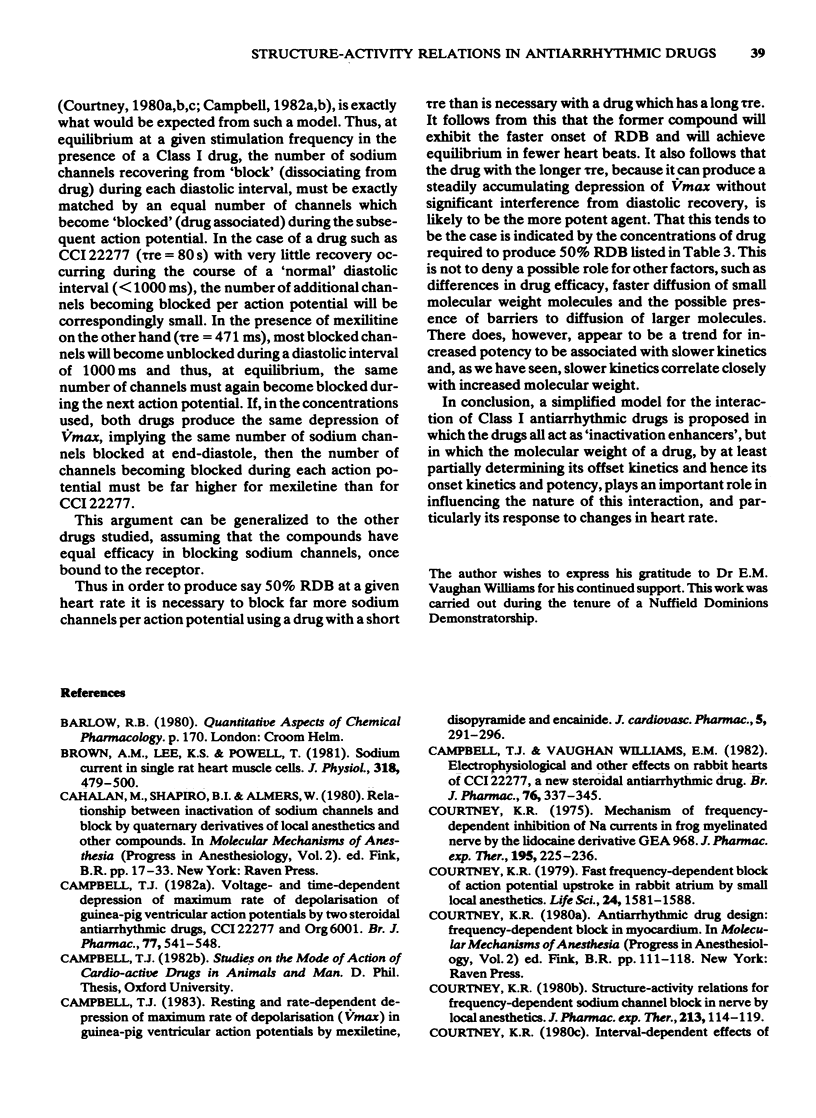
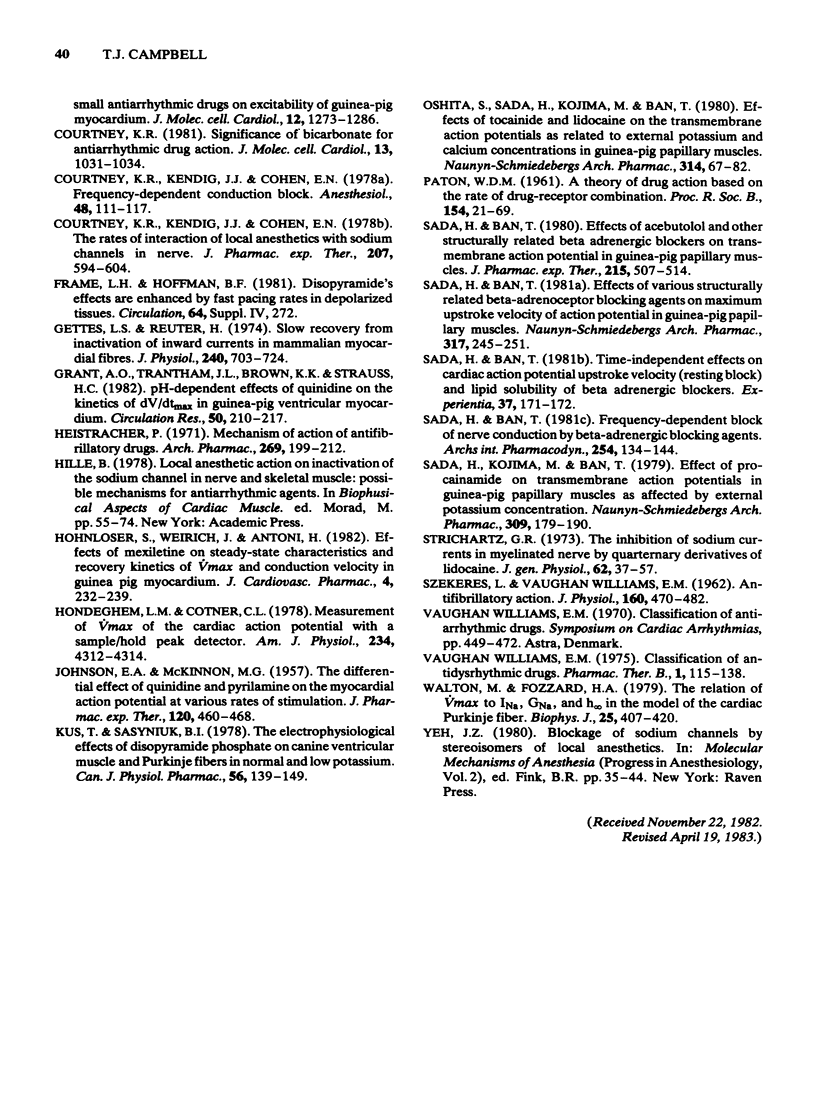
Selected References
These references are in PubMed. This may not be the complete list of references from this article.
- Brown A. M., Lee K. S., Powell T. Sodium current in single rat heart muscle cells. J Physiol. 1981 Sep;318:479–500. doi: 10.1113/jphysiol.1981.sp013879. [DOI] [PMC free article] [PubMed] [Google Scholar]
- Campbell T. J. Resting and rate-dependent depression of maximum rate of depolarisation (Vmax) in guinea pig ventricular action potentials by mexiletine, disopyramide, and encainide. J Cardiovasc Pharmacol. 1983 Mar-Apr;5(2):291–296. doi: 10.1097/00005344-198303000-00021. [DOI] [PubMed] [Google Scholar]
- Campbell T. J., Vaughan Williams E. M. Electrophysiological and other effects on rabbit hearts of CCI22277, a new steroidal antiarrhythmic drug. Br J Pharmacol. 1982 Jun;76(2):337–345. doi: 10.1111/j.1476-5381.1982.tb09225.x. [DOI] [PMC free article] [PubMed] [Google Scholar]
- Campbell T. J. Voltage- and time-dependent depression of maximum rate of depolarization of guinea-pig ventricular action potentials by two steroidal antiarrhythmic drugs, CCI 22277 and ORG 6001. Br J Pharmacol. 1982 Nov;77(3):541–548. doi: 10.1111/j.1476-5381.1982.tb09329.x. [DOI] [PMC free article] [PubMed] [Google Scholar]
- Courtney K. R. Fast frequency-dependent block of action potential upstroke in rabbit atrium by small local anesthetics. Life Sci. 1979 Apr 23;24(17):1581–1588. doi: 10.1016/0024-3205(79)90019-5. [DOI] [PubMed] [Google Scholar]
- Courtney K. R. Interval-dependent effects of small antiarrhythmic drugs on excitability of guinea-pig myocardium. J Mol Cell Cardiol. 1980 Nov;12(11):1273–1286. doi: 10.1016/0022-2828(80)90071-1. [DOI] [PubMed] [Google Scholar]
- Courtney K. R., Kendig J. J., Cohen E. N. Frequency-dependent conduction block: the role of nerve impulse pattern in local anesthetic potency. Anesthesiology. 1978 Feb;48(2):111–117. [PubMed] [Google Scholar]
- Courtney K. R., Kendig J. J., Cohen E. N. The rates of interaction of local anesthetics with sodium channels in nerve. J Pharmacol Exp Ther. 1978 Nov;207(2):594–604. [PubMed] [Google Scholar]
- Courtney K. R. Mechanism of frequency-dependent inhibition of sodium currents in frog myelinated nerve by the lidocaine derivative GEA. J Pharmacol Exp Ther. 1975 Nov;195(2):225–236. [PubMed] [Google Scholar]
- Courtney K. R. Significance of bicarbonate for antiarrhythmic drug action. J Mol Cell Cardiol. 1981 Nov;13(11):1031–1034. doi: 10.1016/0022-2828(81)90479-x. [DOI] [PubMed] [Google Scholar]
- Courtney K. R. Structure-activity relations for frequency-dependent sodium channel block in nerve by local anesthetics. J Pharmacol Exp Ther. 1980 Apr;213(1):114–119. [PubMed] [Google Scholar]
- Gettes L. S., Reuter H. Slow recovery from inactivation of inward currents in mammalian myocardial fibres. J Physiol. 1974 Aug;240(3):703–724. doi: 10.1113/jphysiol.1974.sp010630. [DOI] [PMC free article] [PubMed] [Google Scholar]
- Grant A. O., Trantham J. L., Brown K. K., Strauss H. C. PH-Dependent effects of quinidine on the kinetics of dV/dtmax in guinea pig ventricular myocardium. Circ Res. 1982 Feb;50(2):210–217. doi: 10.1161/01.res.50.2.210. [DOI] [PubMed] [Google Scholar]
- Heistracher P. Mechanism of action of antifibrillatory drugs. Naunyn Schmiedebergs Arch Pharmakol. 1971;269(2):199–212. doi: 10.1007/BF01003037. [DOI] [PubMed] [Google Scholar]
- Hohnloser S., Weirich J., Antoni H. Effects of mexiletine on steady-state characteristics and recovery kinetics of V max and conduction velocity in guinea pig myocardium. J Cardiovasc Pharmacol. 1982 Mar-Apr;4(2):232–239. doi: 10.1097/00005344-198203000-00011. [DOI] [PubMed] [Google Scholar]
- JOHNSON E. A., McKINNON M. G. The differential effect of quinidine and pyrilamine on the myocardial action potential at various rates of stimulation. J Pharmacol Exp Ther. 1957 Aug;120(4):460–468. [PubMed] [Google Scholar]
- Kus T., Sasyniuk B. I. The electrophysiological effects of disopyramide phosphate on canine ventricular muscle and Purkinje fibers in normal and low potassium. Can J Physiol Pharmacol. 1978 Feb;56(1):139–149. doi: 10.1139/y78-018. [DOI] [PubMed] [Google Scholar]
- Oshita S., Sada H., Kojima M., Ban T. Effects of tocainide and lidocaine on the transmembrane action potentials as related to external potassium and calcium concentrations in guinea-pig papillary muscles. Naunyn Schmiedebergs Arch Pharmacol. 1980 Oct;314(1):67–82. doi: 10.1007/BF00498433. [DOI] [PubMed] [Google Scholar]
- Sada H., Ban T. Effects of acebutolol and other structurally related beta adrenergic blockers on transmembrane action potential in guinea-pig papillary muscles. J Pharmacol Exp Ther. 1980 Nov;215(2):507–514. [PubMed] [Google Scholar]
- Sada H., Ban T. Effects of various structurally related beta-adrenoceptor blocking agents on maximum upstroke velocity of action potential in guinea-pig papillary muscles. Naunyn Schmiedebergs Arch Pharmacol. 1981 Nov;317(3):245–251. doi: 10.1007/BF00503825. [DOI] [PubMed] [Google Scholar]
- Sada H., Ban T. Frequency-dependent block of nerve conduction by beta-adrenergic blocking agents. Arch Int Pharmacodyn Ther. 1981 Nov;254(1):134–144. [PubMed] [Google Scholar]
- Sada H., Ban T. Time-independent effects on cardiac action potential upstroke velocity (resting block) and lipid solubility of beta adrenergic blockers. Experientia. 1981 Feb 15;37(2):171–172. doi: 10.1007/BF01963214. [DOI] [PubMed] [Google Scholar]
- Sada H., Kojima M., Ban T. Effect of procainamide on transmembrane action potentials in guinea-pig papillary muscles as affected by external potassium concentration. Naunyn Schmiedebergs Arch Pharmacol. 1979 Nov;309(2):179–190. doi: 10.1007/BF00501227. [DOI] [PubMed] [Google Scholar]
- Strichartz G. R. The inhibition of sodium currents in myelinated nerve by quaternary derivatives of lidocaine. J Gen Physiol. 1973 Jul;62(1):37–57. doi: 10.1085/jgp.62.1.37. [DOI] [PMC free article] [PubMed] [Google Scholar]
- Szekeres L., Williams E. M. Antifibrillatory action. J Physiol. 1962 Mar;160(3):470–482. doi: 10.1113/jphysiol.1962.sp006860. [DOI] [PMC free article] [PubMed] [Google Scholar]
- Vaughan Williams E. M. Classification of antidysrhythmic drugs. Pharmacol Ther B. 1975;1(1):115–138. doi: 10.1016/0306-039x(75)90019-7. [DOI] [PubMed] [Google Scholar]
- Walton M., Fozzard H. A. The relation of Vmax to INa, GNa, and h infinity in a model of the cardiac Purkinje fiber. Biophys J. 1979 Mar;25(3):407–420. doi: 10.1016/S0006-3495(79)85312-6. [DOI] [PMC free article] [PubMed] [Google Scholar]


